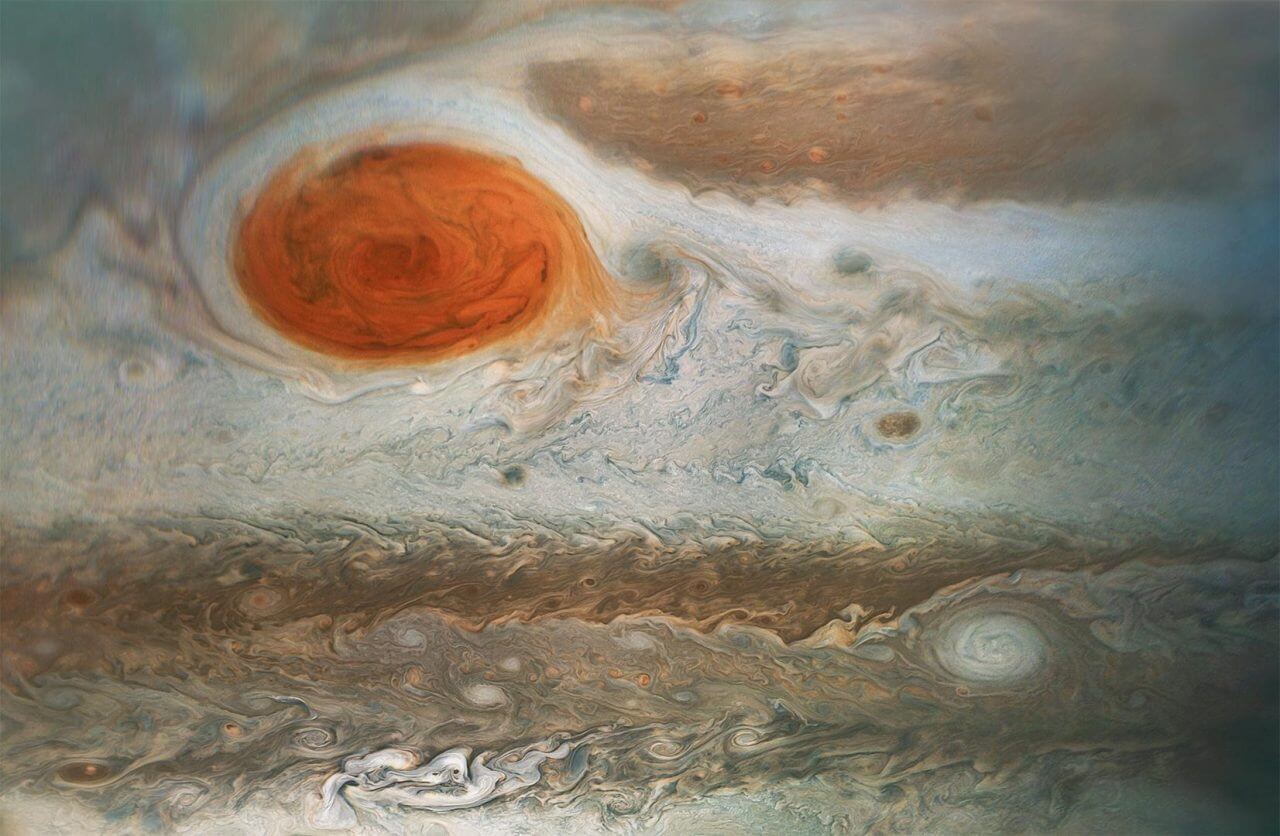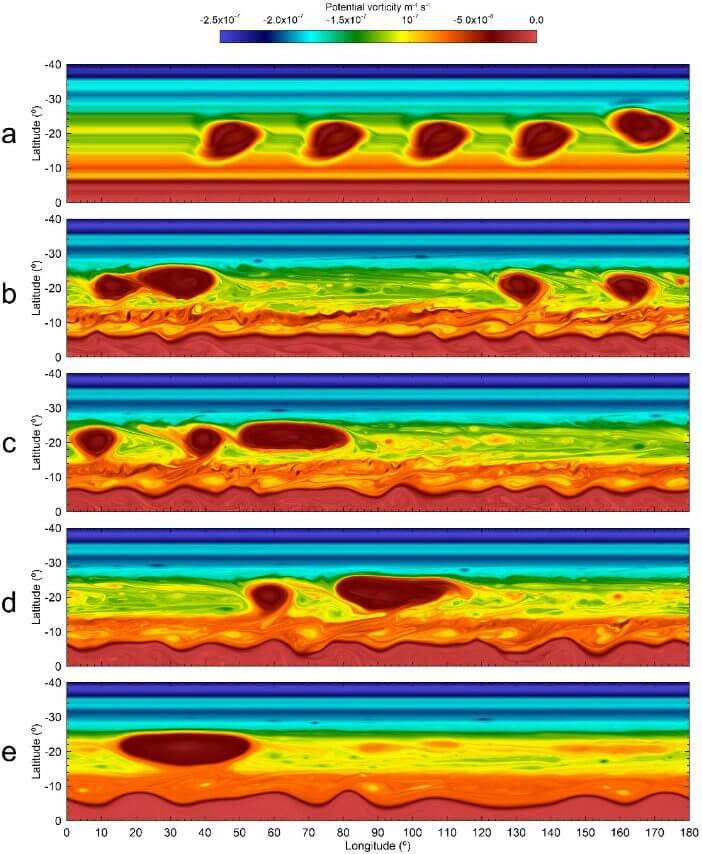Huge storm on the surface of JupiterBig red spotThe great red spot is known for its size, bright red color, and extremely long lifespan. In particular, regarding human lifespan, Giovanni Cassini discovered in 1665,Permanent stainsThere is a theory that the “Permanent Spot” is the same as the present-day Great Red Spot, and that it has been around ever since. If this theory is correct, the Great Red Spot would be at least 359 years old, but this estimate is disputed.
A research team led by Agustín Sánchez La Vega of the University of the Basque Country examined observational records of Jupiter from the 17th century to the present, and performed simulations of Jupiter's atmosphere based on the latest observational data. Results,The current Great Red Spot is likely different from the permanent one discovered by Cassini.I understand that. In this case,The current Great Red Spot was first observed in 1831, meaning it is at least 193 years old.

■How old is Jupiter’s giant storm “The Great Red Spot”?
Jupiter, the largest planet in the solar system, has storms of various sizes consisting of spiral clouds. Most prominent in the Southern Hemisphere.Big red spot''It's a huge storm. The somewhat oval-shaped Great Red Spot is about 14,000 kilometers in diameter, larger than Earth, and constantly battered by violent winds of up to 125 m/s. This wind speed is comparable to the instantaneous maximum wind speed of a very strong hurricane, which rarely occurs in Earth's atmosphere.
It is not well understood why the red color, which is the origin of the name of the Great Red Spot, is caused by anticyclonic storms.(※1)Based on the characteristics of the Great Red Spot, when clouds in the upper part of the atmosphere are blown away by downdrafts, material in the lower part of the atmosphere is exposed, and the red material produced by photochemical changes caused by sunlight is believed to be the object.
The Great Red Spot, so visible on Jupiter's surface, is said to be several hundred years old or more, as recorded in ancient astronomical observations. However, the true age of the Great Red Spot has been debated. The most popular theory is that it has been around for more than 300 years since it was discovered by Giovanni Cassini in 1665.(※2). In this case, the Great Red Spot would be at least 359 years old in 2024.
Cassini and other astronomers continued to observe Jupiter's storms from 1665 to 1713, and due to their long lives,Permanent stains“It was called. Although the color of the permanent spot is not mentioned in the astronomical records themselves, it is a group of works created by the artist Donato Creti in 1711 with the advice of astronomers.Astronomical observation』(※3)This indicates that the permanent spots were red in color. This is the basis for assuming that the Permanent Spot of the 17th century and the Great Red Spot of today are the same thing.
![[▲ الشكل 2: سجلات مراقبة كوكب المشتري في العصور المختلفة. كانت هناك فجوة بين عامي 1713 و1831 عندما لم يتم ملاحظة البقعة الحمراء الكبرى، ويبدو أن حجم البقعة الحمراء الكبرى قد زاد خلال تلك الفترة. (مصدر الصورة: تم التعديل من Agustín Sánchez-Lavega، وآخرون. / الإضافات إلى النص وعكس الصورة من الشمال إلى الجنوب من قبل المؤلف (Riri Aya))]](https://sorae.info/wp-content/uploads/2024/06/2024-06-22-Great_Red_Spot-02.jpg)
![[▲ الشكل 2: سجلات مراقبة كوكب المشتري في العصور المختلفة. كانت هناك فجوة بين عامي 1713 و1831 عندما لم يتم ملاحظة البقعة الحمراء الكبرى، ويبدو أن حجم البقعة الحمراء الكبرى قد زاد خلال تلك الفترة. (مصدر الصورة: تم التعديل من Agustín Sánchez-Lavega، وآخرون. / الإضافات إلى النص وعكس الصورة من الشمال إلى الجنوب من قبل المؤلف (Riri Aya))]](https://sorae.info/wp-content/uploads/2024/06/2024-06-22-Great_Red_Spot-02.jpg)
However, the record of observation of permanent sites ended in 1713, until the next observation record by Heinrich Schwabe in 1831.Observation gap of 118 years!There. Jupiter continued to be observed during this gap, so if the Permanent Spot was the same storm as the Great Red Spot and had persisted after 1713, it would have been of interest to astronomers for more than a century, meaning it was neither mapped nor left in the map. It might even be more plausible to believe that the Permanent Spot disappeared during the gap, and that the Great Red Spot was born recently as a separate storm.
-Sponsor's drink-
However, the mechanism by which giant storms like the Great Red Spot arise and disappear, and how storms expand and contract are not well understood, so it is unlikely that the current Great Red Spot is symmetrical or not and this has been the issue that has remained unresolved.
*1…It is estimated that more than 90% of storms on Jupiter are anticyclonic storms with strong downdrafts. On Earth, low pressure creates storms that worsen the weather, while high pressure brings sunny skies, so it may be hard to imagine, but anticyclonic storms that can cause disasters also occur on Earth. For example, the Hartmut surge (known as the “Beast from the East”) that occurred in the United Kingdom in 2018 is an example of an anticyclonic storm that brought intense cold waves.
*2…There are claims that similar storms were recorded in observational records before 1665, but there is some dispute as to whether the same storm was observed, some of which have been clearly denied. Therefore, the oldest reliable continuous record dates from 1655.
*3: A series of eight paintings by Donato Creti in 1711, said to have been commissioned by the naturalist Luigi Ferdinando Marsili in order to encourage Pope Clement XI to establish an astronomical observatory. He is said to have received advice from astronomers Eustachio Manfredi and Giovanni Cassini to accurately photograph planets and comets.
■The Great Red Spot is likely different from Cassini's Permanent Spot.
Sanchez LaVega and his team conducted research to uncover the secret of the age of Jupiter's Great Red Spot. First, they examined observational records of the Permanent Spot and the Great Red Spot from different eras, from diagrams from 1665 to digital images from 2023. Next, based on observational results from NASA's Juno spacecraft, we will use the Center for Computing's MareNostrum supercomputer Supercell in Barcelona to explore Jupiter, and we simulated a storm.


First, the simulation revealed the mechanism by which giant storms are generated. Jupiter's atmosphere contains many atmospheric currents running in opposite directions at certain latitudes, and where they collide, multiple small eddies are created and the flows become unstable. When air flows faster than the surrounding area in such a place, an extremely large vortex is generated, which can be called the “primordial Great Red Spot,” and stabilizes in a short period of time without disappearing. The Great Red Spot becomes smaller over time, as wind speeds increase. This development indicates that the great red spot is becoming smaller over time.
Looking at Jupiter observation records, the Great Red Spot, which has been observed continuously since 1831, appears to be shrinking over time. For exampleThe Great Red Spot, first photographed in 1879, is a highly elongated oval shape, measuring at its longest point about 39,000 kilometers.You will become.
Compared to the Great Red Spot in 1879, the current Great Red Spot has an oval shape close to a perfect circle, and a much smaller diameter, about 14,000 km. From these facts, it is very likely that the Great Red Spot spotted in 1831 was observed soon after its birth, and is different from the permanent spot that has been around since 1665.
■The fate of the Great Red Spot is the subject of the following research
The new study shows that the Great Red Spot has not been continuously present since 1665;He was likely born around 1831.It shows that. In this case, the Great Red Spot would be at least 193 years old.
Jupiter's storms are much larger than those on Earth, and the full details of their mechanisms are still unknown. The next research goal for Sánchez La Vega and his colleagues is to determine what small storms like the Great Red Spot must become before they disappear, or whether they will continue to exist stably. Understanding this will help us understand not only the fate of Jupiter's Great Red Spot, but also the mechanisms and fate of storms on other planets like Saturn, as well as exoplanets and brown dwarfs.
source
Text / Riri Ayaka Editing / sorae editorial department

“Travel maven. Beer expert. Subtly charming alcohol fan. Internet junkie. Avid bacon scholar.”






More Stories
The ranking of the best survival horror games selected by the IGN US editorial team has been released! Resident Evil RE:2 ranked first
Enjoy a hot cigarette while looking at whales and tropical fish under the sea ⁉︎ “Ploom Dive” is an amazing spatial video experience using Apple Vision Pro
Apple Watch now supports sleep apnea, watchOS 11 released – Impress Watch